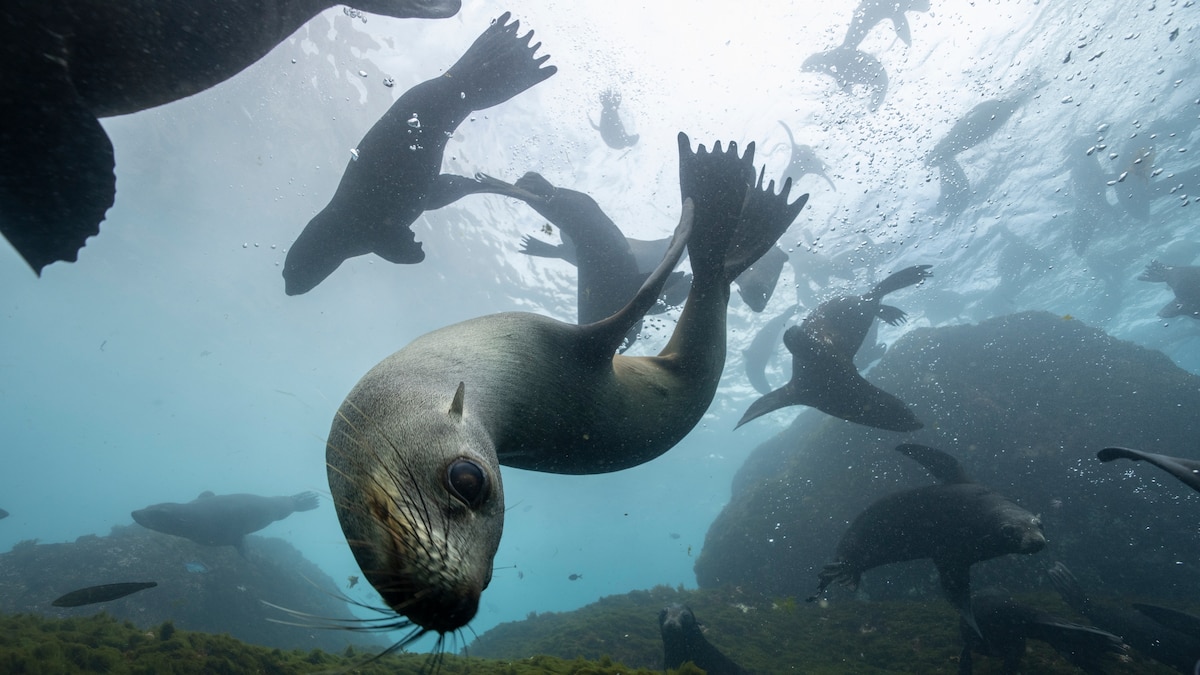Now Reading: A quiet island experiment reveals a battle of the bees
-
01
A quiet island experiment reveals a battle of the bees
A quiet island experiment reveals a battle of the bees

Since 2018, honeybees have feasted on wildflowers across a remote Italian island called Giannutri every spring. But for the last four years, Lorenzo Pasquali had the unusual task of shutting the honeybee hives down and watching wild bees as they scrambled to claim the flowers, racing for every drop of nectar in the absence of their domesticated rivals.
Managed honeybees, often used in agriculture, and native bees feast on the same floral nectars and pollens. Ecologists have long suspected that honeybees may be pushing wild bees to the margins, but carrying out experiments in these wild insects has turned out to be tricky. Pasquali, an ecologist now at the University of Bialystok, Poland, and his colleagues turned the islet—just over half the size of New York’s Central Park—into a living laboratory to test honeybees’ impact.
The results, recently published in the journal Current Biology, suggest that wild bee numbers alarmingly dropped. With the temporary removal of honeybees, nectar and pollen levels surged, allowing wild bees to forage more and feed on nectar longer and altering their daily routines.
“It is surprising and a nice experiment,” says Alfredo Valido, an entomologist at the Instituto de Productos Naturales y Agrobiología in Spain, who was not involved in the research. The researchers designed a very clear experiment relating honeybees, flowers and wild bees, he adds.

A new honeybee (Apis mellifera) emerges from a brood cell to live for six short weeks. It spends that time foraging for food, making honey, and raising the next generation.
Composite Photograph by Anand Varma, Nat Geo Image Collection

The buff-tailed bumblebee (Bombus terrestris) was one of two wild species that saw a drop in numbers on Giannutri Island after honeybees were introduced.
Photograph by Chris Gomersall, 2020VISION/Nature Picture Library
Putting honeybees on pause
Beekeepers first brought honeybee queens to Giannutri to raise them in isolation. The island is part of the Tuscan Archipelago National Park, and in 2021, authorities asked Pasquali’s advisor, entomologist Leonardo Dapporto of the University of Florence to investigate whether managed honeybees that were recently brought to the island might have an unexpected ecological fallout. Hiking the island with another colleague, Alessandro Cini of the University of Pisa, they noticed plenty of honeybees buzzing around, but just a few wild bees.
“What if tomorrow there are no honeybees on the island?” Dapporto wondered. “How [would] the behavior of wild bees change?”
The team decided to use the island as a natural experiment. Every other morning, Pasquali would seal off the entrances to all 18 honeybee hives on alternating mornings, making sure the honeybees couldn’t leave. Then, he and fellow researchers would observe the island’s wild pollinators. The bees were kept inside until late afternoon—just long enough for researchers to observe how wild bees behaved in their absence.
“It was a unique experience. Never boring,” Pasquali says. “I still remember every plant and rock on the island.”
For Pasquali and his teammates, identifying native wild bees was easy. The wild bees are bigger and darker with bright colors. The wild bees also fly with a distinct buzzing sound compared to the honeybees. The researchers tracked how often wild bees entered or exited plots of land, tracking how often they visited flowers, and how long they spent drinking nectar. Using delicate tubes, they also measured the volume of nectar available for the wild bees in presence or absence of honeybees.
You May Also Like
The team found that when honeybees were locked in their hives, nectar volume increased by over 50 percent in some plants, while pollen level spiked by nearly 30 percent. Subsequently, the researchers found an increased level of searching behavior in wild bees and they also sucked in nectar for a longer time.
Over four years, as the team carried out surveys on the island to monitor wild bee populations, they found that Anthophora dispar, a solitary native bee species, and Bombus terrestris, a type of bumblebee, fell by nearly 80 percent compared to their population level at the start of the study in 2021.
While in the beginning of the experiment researchers expected to see some impacts to the wild bees, “we didn’t imagine that the impact was this strong,” Dapporto says. The dataset is still a correlation, he adds, but the fact that the wild bee population declined so significantly after the introduction of honeybees puts them on the prime focus compared to other factors.

Commercial beekeeping, like this operation on a ranch in California, is extremely important for agriculture, but honeybees may threaten native wild species when they’re introduced to protected areas.
Photograph by Anand Varma, Nat Geo Image Collection
From science to action
“We are not against beekeeping practice,” Dapporto adds. But when honeybees are introduced into protected areas, especially those home to rare, endangered, or native wild bee species, park authorities should exercise great caution and ecological assessment.
Wild bees on bigger islands and even in sensitive protected areas in mainland regions might be facing similar fates, if honeybees have been introduced without proper assessment, the team says. Wild bees face a range of threats, from habitat loss and climate change to pesticide exposure. But unlike many of these pressures, competition from honeybees is something humans can actively manage.
As soon as Dapporto’s team informed the national park about the results, the park immediately took action, halting the practice of beekeeping starting this year. That makes the results even more impressive, Valido says, commending the quick action. “It’s not logical to introduce [managed species] in an area where you want to preserve the flora and fauna,” he adds.
In addition to beekeeping, “sometimes conservation areas have a variety of land uses for things like pasture cattle and sheep,” says Victoria Wojcik, Science Director at the Pollinator Partnership Canada, a non-profit dedicated for the conservation of pollinators. Even in these cases, conservationists should look at the ecosystem resources to avoid overstocking. But for an area designated as a critical habitat for an invertebrate species, specifically a bee, “I would be really confused as to why someone would consider permitting honeybee keeping in that landscape,” she adds.
As for Dapporto and his team, they are continuing to track whether the native wild bees would change their behavior and bounce back in number as the honeybees are removed from the island. The team has already collected some data this year and is planning to continue observation for coming years.
“Then we could see if a longer absence of honeybees will produce a [major] effect on the behavior of wild bees,” he adds.






















